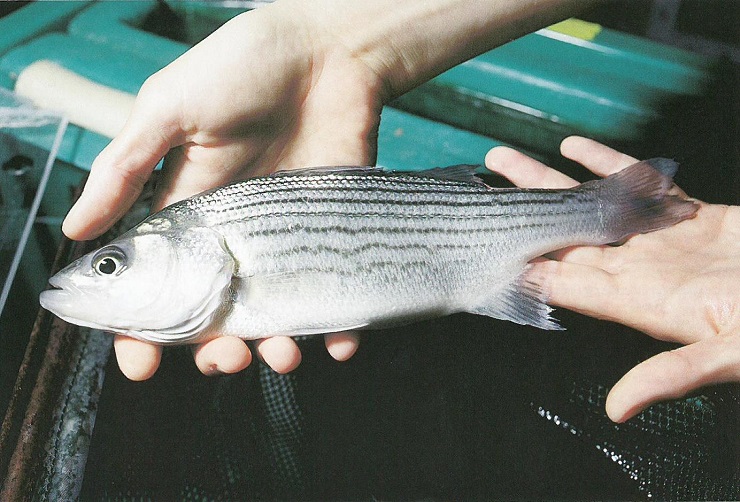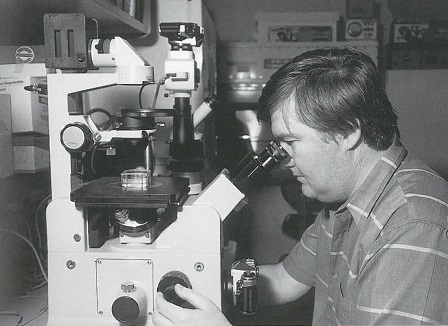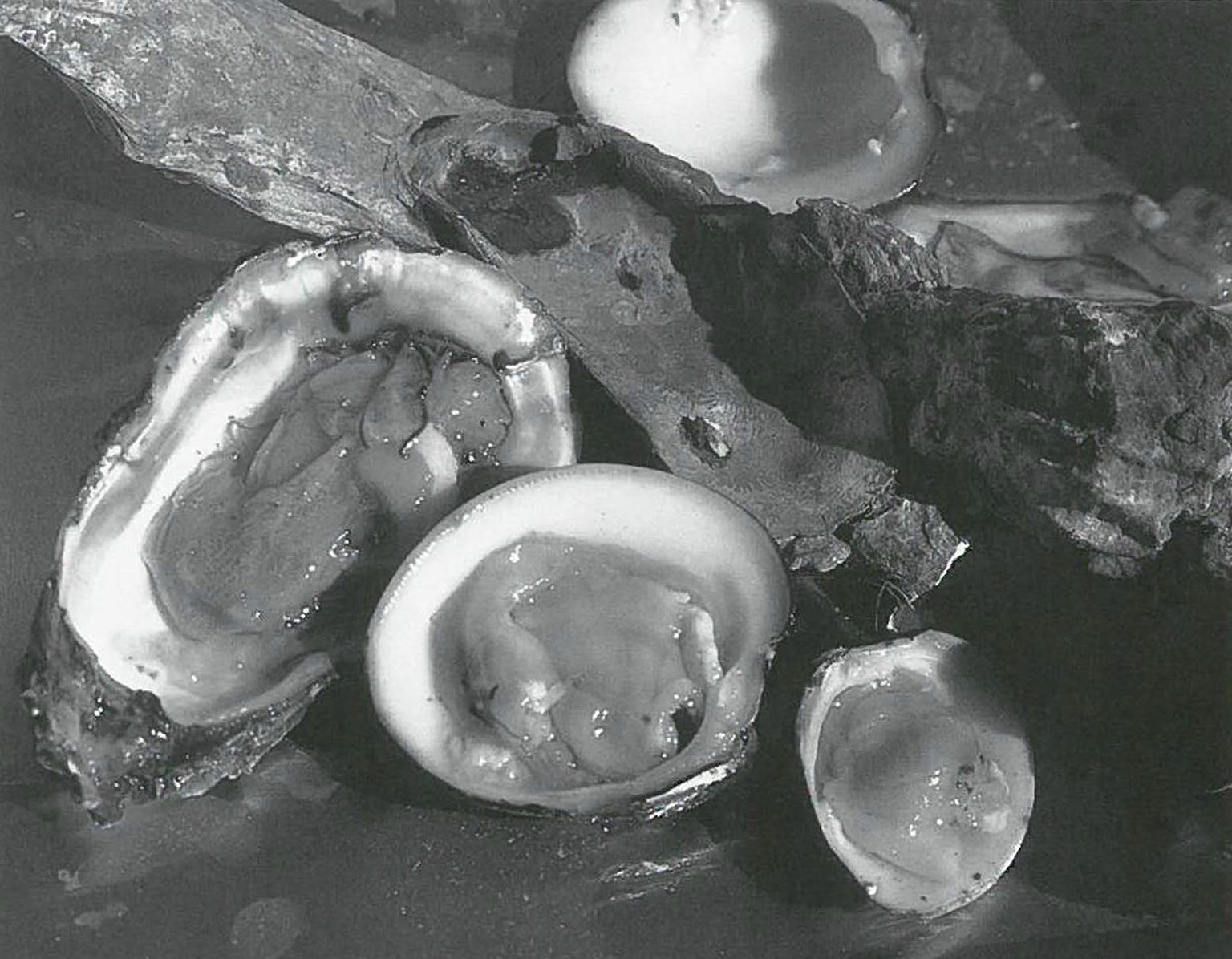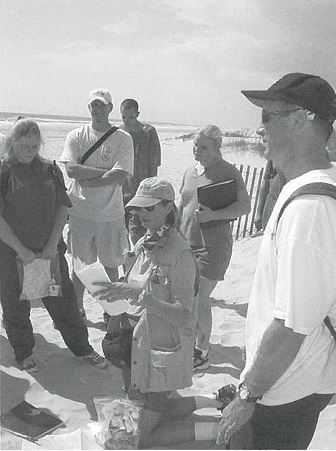Researchers Conduct Breakthrough Studies on Fish Antibiotics

As several silver and black hybrid striped bass swim around in a round tank, North Carolina Sea Grant researcher Ed Noga scoops up a tiny fish.
Although the hybrid striped bass is less than an inch long, it is a “potent” source of antibiotics,” according to Noga, professor at the North Carolina State University College of Veterinary Medicine.
In groundbreaking research, Noga and NC State veterinary medicine graduate student Unapom Silphaduang discovered a new antibiotic in hybrid striped bass — which are raised on fish farms — that may have implications for treating disease in humans and animals.
Named “piscidins” after the Latin word “pisces” or fishes, the antibiotics were isolated from mast cells — the most common tissue immune cell found in fish and other vertebrates, including humans.

Mast cells are present in many tissues, including the skin, respiratory tract — gills or lungs — and the gastrointestinal tract.
This is the frrst time that researchers have isolated a peptide antibiotic from mast cells of any animal, including humans. The study appeared in a recent issue of the prestigious scientific journal Nature.
“The peptide antibiotics or ‘piscidins’ have the potential to fight important bacterial pathogens of both fish and mammals, including multi-drug-resistant bacteria,” says Noga. “The antibiotics could be a useful template for designing new drugs because they are novel structures and not related to any known antibiotic. With the development of antibiotic-resistant bacteria, there is an urgent need to find new types of antibiotics that can fight these resistant pathogens.”
Noga says it is unclear whether fish mast cells are from the same lineage as mammalian mast cells.
“While mast cells are one of the most common immune cells of vertebrates, their role as a critical line of defense is uncertain,” he adds. “However, if any type of peptide antibiotic is also present in human mast cells, it could have important implications for treating human diseases, including asthma, skin allergies and certain types of arthritis, because of the prominent role that mast cells play in these diseases.”
The study also has important implications for the U.S. aquaculture industry, which grew from $45 million for value of products sold in 1974 to more than $978 million in 1998, according to the U.S. Dept. of Agriculture.
The N.C. Dept. of Agriculture & Consumer Services reported that the state’s aquaculture sales exceeded $20.5 million in 2000. Hybrid striped bass was the second highest product in the N.C. aquaculture industry, generating more than $5.3 million in 2000, according to the department.
“The new discovery can lead to ways to protect hybrid sniped bass and other fish against disease without using traditional antibiotics,” says Noga. “This could result in health-costs savings and a higher quality and safer product.”
North Carolina Sea Grant Director Ronald G. Hodson says the cutting-edge research has tremendous potential for hun1an medicine as well as aquaculture and other areas of veterinary medicine. “We believe this discovery is just the beginning of a whole new approach to treating bacterial diseases in humans and other animals.”
What’s next?
Silphaduang, who won one of NOAA’s 2001 Walter B. Jones Memorial Awards in Coastal and Marine Graduate Study, says they will be determining if the mast cells of other animals, including humans, contain antibiotics.
‘We hope to find an answer within the next 12 months,” adds Noga.
New Stress Test
As an aquatic medicine specialist, Noga has done groundbreaking research on a variety of fish, including channel catfish, tilapia and rainbow trout.
David Robinette, a former graduate student at the NC State College of Veterinary Medicine, attributes Noga’ s breakthroughs in fish antibiotic studies to his creativity and attention to details.
“Ed is one of the most thorough scientists I have ever known,” says Robinette, winner of a 1999 Walter B. Jones Memorial Award in Coastal and Marine Graduate Study. “He is always on top of what his research assistants are doing in the lab and helping them to develop critical thinking skills. He never leaves a stone unturned.”

In 1987, Noga’s lab was the first to develop a method for in vitro culture of the parasite Amyloodinium ocellatum, one of the most important pathogens affecting marine fish.
A year later, Noga and former NC State College of Veterinary Medicine graduate student Stephen Smith identified a toxic dinoflagellate later named Pfiesteria, which has been associated with numerous fish kills and health problems in coastal waters.
In 2000, Noga and Robinette used channel catfish to develop a new stress test for fish.
The researchers identified naturally occurring antibiotics in channel catfish that may be a promising indicator for monitoring fish health in the expanding aquaculture industry.
The scientists found that polypeptides called histone-like proteins (HLPs) are likely an important component of nonspecific immunity in channel catfish. Nonspecific immunity protects against many different diseases at once.
Specific immunity protects against a single pathogen. Thus, in some ways, nonspecific immunity can be considered a “natural broadspectrum protectant.”
‘These HLPs were found in the spleen, skin, and gills and are probably in other tissues of catfish,” says Noga. “So these HLPs appear to be everywhere. This is siginficant because it suggests that HLPs may be important in protecting against many diseases. We also found these types of antibiotics in rainbow trout and hybrid striped bass.”
In the study, catfish were exposed to chronic stress — from overcrowding and elevated ammonia — for several weeks. This stress caused a significant decline in HLP levels in the skin without any visibly apparent change in the health of the fish. This indicates that HLPs could alert farmers when their fish are at risk for becoming sick, but before any visible clues are apparent.
“This suggests that monitoring HLP levels in the skin — especially during early stages of stress — can help farmers to detect problems before they become catastrophic,” says Noga.
The identification of a stress test usable in the field would be important for the aquaculture industry where fish are reared under very high stocking densities, offering potential for disease outbreaks.
The channel catfish industry is the largest aquaculture sector in the United States, generating over $400 million annually, according to Noga.
In North Carolina, the total estimated value of catfish aquaculture in 200) was nearly $3.5 million, according to the N.C. Department of Agriculture & Consumer Services.
“One of the major goals of a successful aquaculture enterprise is to avoid a disease epidemic,” says Noga. ‘This typically involves stress reduction in fish stocks.”
However, there are no practical tests available for fish farmers to use in detecting fish stress, according to Noga. “All the stress tests for fish are too expensive, labor-intensive, or not very useful in assessing health in the field,” he adds. “We are hoping to develop a test for fish farmers that can done on-site in less than 30 minutes.”
Hodson says this re.search has important implications for the marine aquaculture industry. “There are few antibiotics to treat fish,” he adds. ‘This test might give growers a chance to detect health problems earlier — and thus avoid the need for drug intervention.”
FRG Project
Through a N.C. Fishery Resource Grant (FRG), Noga is working with veteran crabber Robin Doxey of Merritt and Bill Gordon of Bethyl Labs in Texas to develop a blood test for peelers — crabs that are about to shed their shells. The FRG program is funded by the N.C. General Assembly and administered by North Carolina Sea Grant.
Noga’s goal is for shedders and fishery managers to administer a simple test.
“This test is based on the same principal as the one for channel catfish,” says Noga. “The blue crab has a potent antibiotic in its blood. Crabs from highly stressed environments have less of this antibiotic compared to crabs that are less stressed. Crabs with shell disease have even less of this antibiotic.”
In North Carolina, blue crabs, including soft and peeler crabs, are a valuable fishery. From 1999 to 2000, the value of soft-shell crabs jumped from about $2. l million to $3.3 million, according to the N.C. Division of Marine Fisheries.
“Mortality is a serious concern in shedding operations and has in many instances caused considerable economic losses,” adds Noga.
Shedding operations use high-density, recirculating systems that can increase the risk of disease and mortality, according to Noga. Now, crabbers rely on observation and measures of water quality, including dissolved oxygen and ammonia levels, to determine the health of crabs.
“Simply observing a crab is a very inaccurate indicator of health or survivability, unless the crab is near death,” says Noga.
“While maintaining high dissolved oxygen and low ammonia levels is important for shedding, problems often occur when these levels are normal because you cannot measure all water quality factors that adversely affect blue crabs.”
With the test, crabbers will be able to quickly and precisely determine when crabs are stressed so that corrective measures can be taken before mortality occurs.
“We hope that these types of tests will become one of the most useful tools that we have for health management of aquatic populations,” Noga says.
This article was published in the Winter 2002 issue of Coastwatch.
For contact information and reprint requests, visit ncseagrant.ncsu.edu/coastwatch/contact/.
- Categories:


